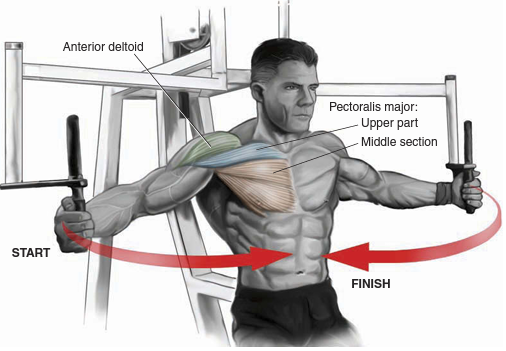A large thick chest is generally one of the primary goals of any weight trainer or bodybuilder.
To understand how to build a massive chest you must first understand what muscles comprise the chest and how to target them specifically.
In building a strong, powerful chest we target a number of muscles: the Pectoralis Major and Minor, and to a lesser degree the Serratus Anterior, the Intercostals and the Front Deltoids.
The primary and most visible muscle of the chest is the Pectoralis Major. It is a thick muscle in a triangular fan shape across the entire chest area. It is connected to the skeleton at three different points, the sternum, the clavicle (collar bone) and the shoulder (armpit).
The Pectoralis Major is divided into two sections, the Clavicular section which is the upper portion of the muscle connected to the Clavicle, and the Sternal which is the lower section of the muscle connected to the Sternum. Whilst they are connected in two different areas, they are still the SAME muscle.
There is a common misconception that the upper pec (Clavicular section) is the Pectoralis Major and the lower pec (Sternal section) is the Pectoralis Minor. This is not the case.
The Pectoralis Minor is a smaller triangular shaped muscle actually situated underneath the Pectoralis Major and is not generally visible. However this muscle is trained in conjunction with the Pectoralis Major and when it grows it can help to push the Pectoralis Major out to give the appearance of a bigger chest.
The Serratus Anterior (Small muscles covering the side of the chest wall and around the ribs), Intercostals (Smaller muscles positioned between the ribs) and the Front Deltoids (Shoulder muscles) are all muscles that whilst not part of the chest itself, each perform a stabilising function during chest exercises and when developed properly help give definition to the chest.
By hitting the muscles from different angles using different exercises you will achieve maximum growth of all muscle fibres in the shortest time possible.
The best chest exercises to increase bulk, strength and mass are Compound exercises. Those used primarily for shaping and toning are Isolation exercises.
Compound exercises involve the use of more than one muscle group through different joints in order to perform the exercise movement. Isolation exercises effectively isolate the working muscle and only involve movement though one joint.
Compound chest exercises to increase bulk include the bench press (and variations of), pushups, and dips. While Isolation exercises include flyes, pec dec, cable crossover and dumbbell pullover.
There are other exercises out there but these are just some of the most common.
Here is one of my original chest building routines designed to attack the Pec muscle from 3 different angles. It also provides toning and effectively works the other supporting muscles mentioned above. All exercises should be performed using medium-heavy weights and the target number of reps for each set are listed in brackets:
Incline Bench Press 3 Sets (12, 10, 8)
Dumbbell Bench Press 3 Sets (12, 10, 8)
Lateral Flye 2 Sets (12, 10)
Decline Bench Press 2 Sets (12, 10)
As a note, the best chest exercises to increase bulk are compound exercises performed with Dumbbells. This is because they allow each side of the body to work independently through the full range of movement. However limits on the dumbbell weight range at your gym or home or old injury may mean you are unable to use dumbbells all the time. That is when a barbell should be used.
This chest routine will provide you with a solid base on which to develop a thick powerful chest. I would recommend you use a workout log to record your progress so you know what you have to beat each time you set foot in the gym. Then when you exceed the target reps by one, i.e. you perform 13, 11, 9 it is time to increase the weights.
And always remember that REST is the most important factor in muscle growth!
Article Source: http://EzineArticles.com/523034
















0 comments:
Post a Comment